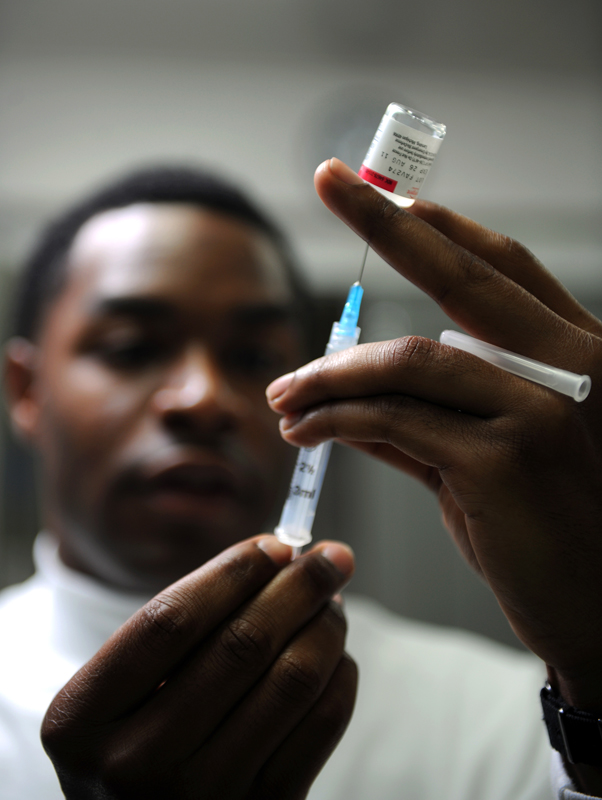 The emergence of the H7N9 bird flu virus has rekindled memories of our last flu pandemic – just as the United States is debating whether it can afford to prepare for the next one.
The emergence of the H7N9 bird flu virus has rekindled memories of our last flu pandemic – just as the United States is debating whether it can afford to prepare for the next one.
Remember the H1N1 flu scare of 2009? I always will, because pregnant women were vulnerable to becoming severely ill or dying from the H1N1 virus, and I was gestating our first kid that year. I felt like a sitting duck as scientists took six long months to develop a vaccine against it.
We weren’t totally defenseless, though. The H1N1 virus was treatable with antiviral drugs that the United States had stored in a national resource called the Strategic National Stockpile. Less than one month after the first U.S. H1N1 cases were detected, the stockpile had shipped 12 million courses of the drugs around the country.
But public health officials are now pondering whether the stockpile can afford to repeat that performance in an age of austerity. The stockpile is like the nation’s all-purpose emergency kit; it stores a huge array of supplies to deal with all kinds of disasters, from bioterror attacks to floods and earthquakes. But the stockpile’s budget will fall increasingly short of its projected costs beginning this year. Officials, who must make cuts, are trying to decide what emergency supplies the nation can live without, and there are no good choices.
My story in Nature this week gives a quick snapshot of how we got here, and here’s the crux of the problem: the stockpile was initially set up to help the nation respond to terrorist attacks, but it has now become an all-purpose disaster resource that cash-strapped state and local governments can’t afford to lose.
Last fall, for instance, workers used materials from the stockpile to set up seven “federal medical stations” – makeshift shelters that do double-duty as field hospitals – in the Northeast after it was devastated by Hurricane Sandy. The stockpile has increasingly been called upon to deploy general-purpose supplies, such as these shelters, for disaster relief.
Meanwhile, the stockpile also has to replenish its supplies of expensive, specialized drugs and vaccines that we’re (thankfully) unlikely ever to use. These drugs, some of which cost thousands of dollars per dose, are targeted towards specific bioterror agents such as smallpox and anthrax. If the stockpile doesn’t buy and store these “countermeasures,” no one else will – and companies might stop making them altogether.
So what do we buy less of – emergency shelters or flu treatments? Antibiotics or anthrax drugs? It’s an almost impossible choice. When some deadly event sweeps our nation, no official wants to be the one who made the call not to buy Drug X, which could have saved even one life. As a society, we’re not comfortable with deciding to do without.
In the end, the H1N1 pandemic turned out not to be as fearsome as it could have been. It claimed no more victims than your garden-variety seasonal flu, and most of the antivirals shipped out from the stockpile weren’t even used.
In our national debate over what we can afford to live without, we can look at this as a lucky break – or as a warning shot across the bow.
***
Credits: Photo of a Navy Corpsman preparing an anthrax vaccination in 2011, courtesy US Department of Defense’s Anthrax Vaccination Information program. Budget data for the Strategic National Stockpile courtesy US Centers for Disease Control and Prevention/Department of Health and Human Services, US Department of Homeland Security, and Gryphon Scientific.
Doncha know we now can be assured of just in time cures for all pandemics? Used to be there were a ton of extra hospital beds for dread and lingering disease, now curable outpatient or with a short stay. So all those beds are unnecessary and a waste. Used to be medical personnel were trained in and practiced scruplous sterile and hygenic technique, now it’s alll curable with antibiotics, so why bother.
It’s all under control at the least cost and greatest profit. Don’t worry. The CDC has everything under control. What’s that, when you call them up you get a recording saying that they are on sequester furlough.